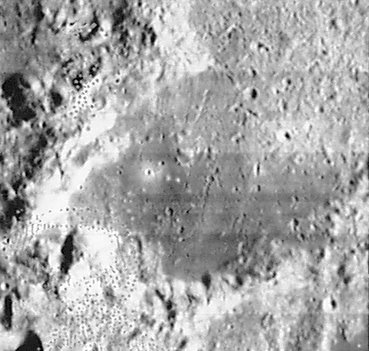Alexander
Contents
Alexander
|
Lat: 40.3°N, Long: 13.5°E, Diam: 81 km, Depth: 0.41 km, Rükl: 13 |
Images
LPOD Photo Gallery Lunar Orbiter Images Apollo Images
- Lunar Orbiter 5's Frame 089 shows a close-up of the remains of the walled plain Alexander. Nearby crater Calippus is seen near the photograph's upper margin. North is to the right. Research Danny Caes
- One could investigate the possible appearances of Alexander on the oblique northward looking Fairchild camera frames of Apollo 15's REV 35. See Images-section at page Calippus (note: this pronounced neighbour of Alexander was indeed captured on several of REV 35's frames).- DannyCaes Mar 25, 2015
Maps
(LAC zone 26A4) LAC map Geologic map
Description
Description: Elger
(IAU Directions) ALEXANDER.--A large irregularly shaped plain, at least 60 miles in longest diameter, enclosed by the Caucasus Mountains. On the S.E. and N.E. the border is lineal. It has a dark level floor on which there is a great number of low hills.
Description: Wikipedia
Additional Information
Depth data from Kurt Fisher database
- Westfall, 2000: 0.41 km
- Cherrington, 1969: 3.07 km
Alexander's crackled western rim
A remarkable Clair-Obscur effect is seen when Alexander's floor is still in darkness (before local sunrise), and several peaks on its western wall are already in sunlight. The appearance of this "Crackled curve of Illuminated beads" looks a bit like the well-known Jewelled Handle at Sinus Iridum (the Montes Jura). This photograph made by Stefan Lammel shows the effect of Alexander's illuminated crackled rim very well!
See also LPOD Moon Last Night (which shows this effect as an eye-catcher on the Waxing Crescent Moon!).
Nomenclature
Alexander the Great (Megas Alexandros; July 20, 356 BC–June 10, 323 BC), also known as Alexander III, was an Ancient Greek king of Macedon (336–323 BC), and one of the most successful military commanders in history. Before his death, he conquered most of the world known to the ancient Greeks.
- Not to be confused with Alexander of Aphrodisias of the so-called Dark Band (or Alexander's Dark Band) which is the dark space between the Primary and Secondary Rainbows.- DannyCaes Mar 30, 2011
- Alexander Beta (hill east of Alexander itself) (see Charts 11 and 20 in the Times Atlas of the Moon).
- Alexander Kappa (hill at the northern part of the rim of Mare Serenitatis) (see Chart 19 in the Times Atlas of the Moon).
- Alexander Phi (hill on the northern part of Mare Serenitatis, south of Alexander Kappa) (see Chart 19 in the Times Atlas of the Moon).
- Alexander Psi (hill east-southeast of Alexander itself) (see Chart 20 in the Times Atlas of the Moon).
LPOD Articles
Bibliography
Although this is not at all related to the nearside crater officially known as Alexander, it could be interesting to know something about a certain J. B. Alexander who's mentioned on page 244 of Burnham's Celestial Handbook (Volume 1). This J. B. Alexander studied the globular star cluster NGC 6397 in the southern constellation Ara, at Radcliffe, together with R. Woolley, L. Mather, and E. Epps (1961). - DannyCaes Apr 30, 2015
Many more Alexanders in the Sourcebook Project (William R. Corliss)
The appearances of the name Alexander (in the Sourcebook Project) is something worthwile to investigate.
- In Mysterious Universe, a handbook of astronomical anomalies (1979) :
- Page 293: The Changing Micrometeoroid Influx (Nature, 1974). Note: the Alexander in this article is (or was?) connected to the Baylor University, Waco, Texas.
- Page 371: Does Zodiacal Light Intensity Vary? (Nature, 1973). Note: in this article, the name Alexander is accompanied by Arthur, Bohn, and Smith (this might have been some sort of research team of four, see: Space Res., 13, 1973).
- Page 471: Concerning the "D" Ring of Saturn (W.A.Feibelman, Nature, 1967). Note: in this article it seems to be a certain A.F.O'D. Alexander.
- In Lightning, Auroras, Nocturnal Lights, and related luminous phenomena (1982) :
- GLB4-R3: A Possible Case of Ball Lightning (William H. Alexander, Monthly Weather Review, 1907).
- In Rare Halos, Mirages, Anomalous Rainbows, and related electromagnetic phenomena (1984) :
- GEH8-R1/R2: Remarkable Optical Phenomenon (S.Alexander, American Meteorological Journal, and Quarterly Journal of the Royal Meteorological Society, 1887). GEH8: Kaleidoscopic Suns.
- In Tornados, Dark Days, Anomalous Precipitation, and related weather phenomena (1983) :
- GWD3-R3: The Fatal Belgian Fog (Jerome Alexander, Science, 1931).
- In Earthquakes, Tides, Unidentified Sounds, and related phenomena (1983) :
- GQH5-R1: Quakewatch (George Alexander, Science 82, 1982).
Note: I (myself) have only 5 books of William R. Corliss (since 1994). I wonder how many more Alexanders there are in all the other books of the Sourcebook Project... - DannyCaes Apr 15, 2015
